SPECIAL
FOCUS: NORTH AMERICAN OUTLOOK
North American offshore rig market’s
spotlight shifts to international waters
Tom Marsh, ODS-Petrodata
The US Gulf of Mexico (US-GOM) rig market
remains the world’s
largest in terms of number of rigs. However, the US-GOM jackup market
remains the weakest link in the global rig market chain, although rig
demand in the deepwater Gulf, and in most of the world’s other
rig markets, remains robust.
US Gulf fleet decline continues
As illustrated in Fig. 1, US-GOM offshore rig supply and demand have
continued on a downward trend for most of the past year. The Gulf rig
market, particularly the jackup market, has never fully recovered from
the drop in activity that occurred after the devastating hurricanes
of 2005. However, due to strong international demand for drilling rigs,
this has not resulted in significant numbers of idle rigs.
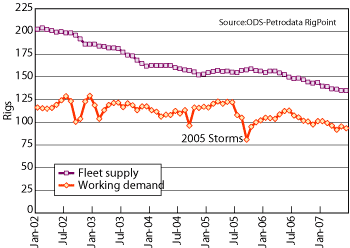 |
Fig.
1. GOM offshore rig supply and demand have
been on a downward trend for most of 2006 and 2007. |
|
As of mid-June 2007, 133 mobile offshore rigs are positioned in the
US Gulf. Of these, 111 have contracts, although not all of the contracted
rigs are working at any given time. Six jackups are reported as being
stacked ready and available by their owners; no mobile rigs of other
types are available.
The US-GOM mobile offshore rig fleet has experienced a net decline
of 18 units over the past 12 months and jackups account for most of
that decline. One year ago, 103 jackups were deployed in the region;
at mid-year 2007, that number is 88.
Of note is the impact the decline in size
has had on the makeup of the region’s current offshore rig fleet. For the most part, the
exodus out of the US Gulf to other markets has involved higher-specification
rigs. Table 1 illustrates the impact, particularly on the jackup fleet’s
composition. The net 15-rig decline in the jackup fleet includes a
net 10 independent-leg cantilever (IC) units rated for 300-ft waters
or deeper, the most desirable rig type for many operators.
| TABLE
1. US Gulf of Mexico rig fleet |
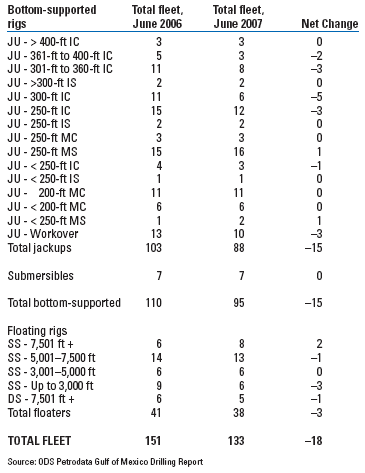 |
|
The net change in the US-GOM floating rig fleet can be attributed
to the movement of deepwater rigs into and out of the area as their
contracts warrant. The decline in the jackup fleet is due to the lack
of long-term work in the area, and rig owners have been fortunate that
strong demand in other markets has allowed them to land firm, well-paying
long-term contracts in international markets.
According to data compiled by ODS-Petrodata, the rig exodus from US
waters is not over. Over the next 12 months, at least eight more rigs
will depart the area for work in West Africa, the Middle East, the
Indian Ocean and Mexico.
Despite the continuing fleet downsizing trend, some evidence points
to stabilization in the US Gulf jackup market. The decline in the working
rig count appears to have leveled out, and as a result, average jackup
and semisubmersible day rates in the region have firmed somewhat in
recent months, Figs. 2 and 3. The number of offshore well permits issued
by the Minerals Management Service (MMS) at mid-year stands at 307,
down by about 11% compared to 2006, but the number of drilling plans
filed by operators has picked up in recent weeks, and is now even with
the year-ago number. As of mid-June this year, operators had filed
192 drilling plans with the MMS.
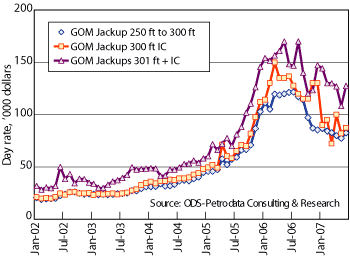 |
Fig.
2. Average GOM jackup day rates have firmed
somewhat in recent months. |
|
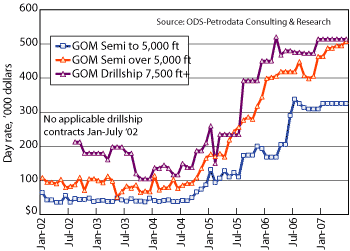 |
Fig.
3. Average GOM floating-rig day rates have
also firmed in recent months. |
|
However, according to ODS-Petrodata’s
most recent US Gulf rig demand forecast, this stabilization can hardly
be characterized as a recovery. As illustrated in Fig. 4, the demand
outlook for the next 12 months can only be characterized as unsettled,
although a more positive upward trend in demand is expected in early
2008. In the jackup market, this increase in activity will be dependent
on the strength of domestic natural gas prices.
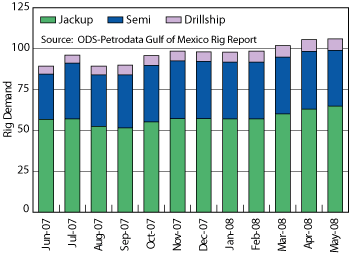 |
Fig.
4. Demand for the next year is unsettled with
a more positive upward trend expected in 2008. |
|
Mexico offers new opportunities
Mexico’s Pemex continues to ramp up its offshore drilling activities,
and the state-controlled company is focusing more on expanding its
efforts into the Mexican Gulf’s deeper waters. This will open
more opportunities for rig owners.
At present, 34 mobile offshore drilling rigs are deployed in Mexican
waters; 33 are working. Thirty of these are jackups, and four are semisubmersibles.
Of the 30 jackups, only five are owned by Mexican companies. The bulk
of the others are owned by US companies, with Noble Drilling and Pride
International each having a particularly strong presence in the market.
In addition, Pemex recently signed another Pride jackup, and the unit
will leave US waters for Mexico in August to start the new one-year
contract.
The jackup market is old hat to Pemex;
it is in the floating rig market that the operator is making a splash.
Pemex recently issued a letter of intent to SeaDragon Offshore that,
if final terms are agreed, will see the newbuild semi, Oban B, mobilize
to Mexico for a 5-yr commitment on delivery in early 2010. SeaDragon’s
new deepwater rig is being built in Russia, although final outfitting
will take place in the UK.
Pemex is taking on even more. The operator also recently awarded a
5-yr contract to Petromena for a newbuild deepwater semi that is under
construction in Singapore. The Petromena rig is also scheduled for
delivery in early 2010. Larsen Oil and Gas will manage the unit while
it is under contract to Pemex.
Both the SeaDragon and Petromena deals
will be undertaken at a reported rate of just over $500,000 per day,
further reinforcing Pemex’s
commitment to move seriously into deepwater exploration and production.
Little activity in Canada
Only two rigs are active in Canadian waters at present, and one of
them will be leaving eastern Canada for the US Gulf this summer. The
second will work in the area into 2008.
Seven operators have plans for or are considering drilling programs
off eastern Canada, but none of these new programs are likely to start
before 2008. Two arctic rigs are deployed in western Canada, one is
cold stacked and the other is being readied to move to US waters off
Alaska to work for Shell.
New rig construction boom continues
As of mid-June, 136 mobile offshore drilling units are under construction
or on order worldwide. The estimated total value of these rigs exceeds
$26 billion, Fig. 5. The estimated total cost of the rigs ordered in
the first half of 2007 is $8.3 billion.
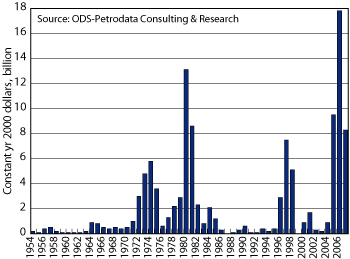 |
Fig.
5. The estimated total value of the 136 mobile
offshore drilling units under construction or on order
worldwide exceeds $26 billion. |
|
Of the 136 units currently on the order books, 100 were ordered on
speculation, that is, without firm contract commitments in hand. The
speculative orders include one tender-assist rig, 10 drillships, 26
semisubmersibles and a remarkable 63 jackups.
As worldwide offshore rig market conditions remain strong, all of
the floating rigs are expected to have work commitments before delivery.
However, the large number of jackups coming into the fleet over the
next few years has some observers wondering if the market can absorb
all of the new capacity without a hiccup or two.
On a worldwide basis, ODS-Petrodata has identified 292 planned or
possible jackup drilling programs that at this writing have no rigs
committed. Given continued strong global energy demand, the new rigs
joining the fleet are more likely to find work than not. Bidding for
some of these programs will be competitive, and some rig owners may
not land the long-term commitments they prefer, but fleet utilization
is expected to remain above 90%. Relatively few of the new rigs are
likely to work in US waters.
The bulk of the rigs on order are being built by Asian yards, but
nine jackups are under construction in US yards at a total estimated
cost of $1.36 billion. The rigs on order at US yards include three
for Rowan Co., one each for Diamond Offshore and Atwood Oceanics, and
four for newcomer Scorpion Offshore.
All of the rigs for Scorpion, Diamond
and Atwood are being built by Keppel AmFELS, the Brownsville, Texas-based
subsidiary of Singapore’s
Keppel group. Keppel has become the world leader in jackup construction.
Total cost of the Texas-built rigs is estimated at $904 million.
The Rowan rigs are being built by Rowan subsidiary LeTourneau in Vicksburg,
Mississippi at a total estimated cost of $455 million.
Relatively few of the 136 rigs under construction
worldwide are likely to go to work in North American waters. Even
the jackups under construction in Texas and Mississippi are not necessarily
candidates for work in the region. US Gulf shelf operators, in particular,
are likely to find themselves with few choices in terms of new, high-specification
jackups, as owners of these rigs will be seeking long-term commitments
whenever possible. 
|
THE
AUTHOR |
|
Tom
Marsh is Vice President/Publisher USA for ODS-Petrodata,
and has been with the company for 20 years. |
|








